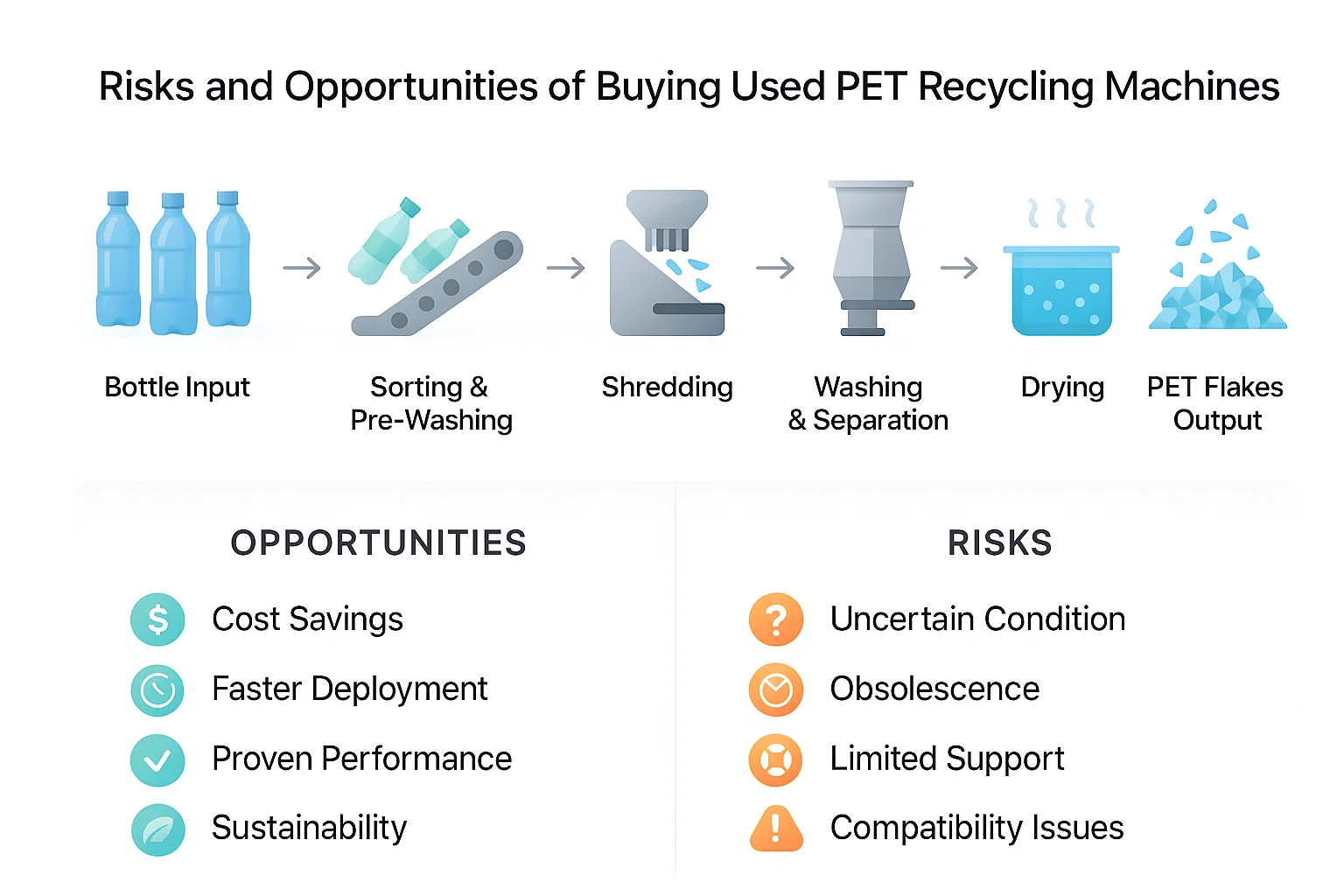As the demand for sustainable practices grows, the recycling industry continues to evolve, with PET (Polyethylene Terephthalate) recycling at the forefront. For industrial buyers, engineers, and professionals in the recycling sector, purchasing used PET recycling machines can be a cost-effective way to enter or expand within this market. However, this decision comes with both risks and opportunities that require careful evaluation. At Energycle, we understand the complexities of this choice and aim to guide you through a comprehensive risk and opportunity assessment to ensure informed decision-making.
This article explores the key considerations when purchasing used PET recycling machines, offering insights into potential benefits, pitfalls, and practical steps to optimise your investment. With a focus on technical precision and industry expertise, we’ll help you navigate this critical decision to support your recycling operations effectively.
Why Consider Used PET Recycling Machines?
Purchasing used PET recycling machines can offer significant advantages, particularly for businesses looking to balance cost with operational efficiency. Below, we outline the primary opportunities associated with this approach.
Risparmio sui costi
New PET recycling machines often come with a high upfront cost, which can be a barrier for small to medium-sized enterprises or those entering the recycling market. Used machines typically cost 30–50% less than their new counterparts, depending on age, condition, and brand. This cost reduction allows businesses to allocate budgets to other critical areas, such as staff training or facility upgrades.
Faster Deployment
Unlike new machines, which may have long lead times due to manufacturing and delivery, used PET recycling machines are often readily available. This enables quicker integration into your operations, reducing downtime and accelerating your return on investment (ROI).
Proven Performance
Many used machines have a track record of performance in real-world conditions. By reviewing maintenance logs and operational history, buyers can gain confidence in a machine’s reliability, provided it has been well-maintained.
Benefici ambientali
Opting for used equipment aligns with the principles of sustainability. By repurposing existing machinery, you reduce the demand for new manufacturing, which consumes energy and resources. This choice reinforces your commitment to eco-friendly practices, enhancing your brand’s reputation.
Risks of Purchasing Used PET Recycling Machines
While the opportunities are compelling, purchasing used equipment carries inherent risks that must be carefully managed. Below, we highlight the key challenges to consider.
Uncertain Condition and Maintenance History
The condition of a used PET recycling machine is critical to its performance. Machines that have been poorly maintained may suffer from wear and tear, leading to frequent breakdowns or suboptimal output. Without a detailed maintenance history, assessing the machine’s reliability can be challenging.
Technological Obsolescence
Older machines may lack the advanced features of newer models, such as energy-efficient motors, automated controls, or compatibility with modern recycling processes. This could limit your ability to meet evolving industry standards or process certain types of PET waste effectively.
Limited Warranty and Support
Unlike new machines, which typically come with manufacturer warranties and technical support, used equipment may have limited or no warranty coverage. This increases the financial risk of unexpected repairs or part replacements.
Compatibility Issues
Integrating a used machine into an existing recycling system can present challenges, particularly if the machine’s specifications differ from your current setup. Mismatched throughput rates, power requirements, or software systems could lead to operational inefficiencies.
Key Factors to Evaluate When Purchasing Used PET Recycling Machines
To mitigate risks and maximise opportunities, a thorough assessment is essential. Below are the critical factors to consider when evaluating a used PET recycling machine.
1. Machine Condition and Maintenance Records
Request detailed maintenance logs, including service history, repairs, and part replacements. Inspect the machine for signs of wear, corrosion, or damage, particularly in high-stress components like shredders, extruders, and washing systems. If possible, arrange for a qualified technician to conduct a pre-purchase inspection.
2. Operational Performance
Assess the machine’s throughput capacity, energy consumption, and output quality. Compare these metrics to industry benchmarks and your operational requirements. For example, a high-quality PET recycling machine should produce clean, uniform PET flakes suitable for applications like bottle-to-bottle recycling. Our Sistema di riciclaggio delle bottiglie in PET is designed to deliver consistent performance, and used machines should be evaluated against similar standards.
3. Manufacturer Reputation and Model Reliability
Research the machine’s manufacturer and model to determine its reputation for durability and performance. Established brands like Energycle are known for producing robust equipment, and used models from reputable manufacturers are more likely to offer long-term reliability.
4. Compatibility with Existing Systems
Ensure the machine integrates seamlessly with your current setup. Check specifications such as power requirements, footprint, and compatibility with downstream processes like pelletising or extrusion. A mismatch could result in costly modifications or reduced efficiency.
5. Supplier Credibility
Purchase from a reputable supplier with a track record of transparency and customer support. Reliable suppliers, like Energycle, provide detailed documentation, offer post-sale support, and may even refurbish used machines to ensure optimal performance.
Workflow of a PET Recycling Machine: Understanding the Process
To better assess a used PET recycling machine, it’s helpful to understand its workflow. The diagram below illustrates the typical stages of a PET recycling process, highlighting key components that should be evaluated for condition and efficiency.
Diagram: PET Recycling Machine Workflow
[Input: PET Bottles] → [Sorting & Pre-Washing] → [Shredding/Grinding] → [Washing & Separation] → [Drying] → [Output: PET Flakes/Pellets]
- Sorting & Pre-Washing: Removes contaminants like labels, caps, and non-PET materials.
- Shredding/Grinding: Breaks PET bottles into smaller flakes for processing.
- Washing & Separation: Cleans flakes to remove residual contaminants, using water and separation technologies.
- Essiccazione: Removes moisture to prepare flakes for downstream applications.
- Produzione: Produces high-quality PET flakes or pellets for reuse in manufacturing.
When inspecting a used machine, focus on the condition of critical components like shredder blades, washing tanks, and drying systems, as these directly impact output quality.
Performance Comparison: New vs. Used PET Recycling Machines
To provide clarity, the table below compares key performance metrics of new and used PET recycling machines, helping you weigh the trade-offs.
| Metric | New PET Recycling Machine | Used PET Recycling Machine |
| Cost | High (£100,000–£500,000) | Lower (£50,000–£250,000) |
| Garanzia | 1–5 years | Limited or none |
| Efficienza energetica | High (modern tech) | Variable (depends on age) |
| Capacità di produzione | Consistent, high | May vary based on condition |
| Technological Features | Advanced automation | May lack modern features |
| Support Availability | Full manufacturer support | Limited, supplier-dependent |
This comparison highlights the importance of balancing cost savings with potential limitations in performance and support when opting for used equipment.
Practical Steps to Mitigate Risks
To ensure a successful purchase, follow these actionable steps:
- Conduct a Thorough Inspection: Engage a qualified engineer to assess the machine’s mechanical and electrical components. Test the machine under operational conditions if possible.
- Request Documentation: Obtain maintenance records, operational manuals, and any available warranty information.
- Negotiate Refurbishment: If the machine requires upgrades, negotiate with the supplier to include refurbishment or replacement of worn parts.
- Plan for Integration: Work with your engineering team to confirm compatibility with existing systems and plan any necessary modifications.
- Partner with Trusted Suppliers: Choose suppliers like Energycle, who offer transparency and support for both new and used equipment. Explore our Sistema di riciclaggio delle bottiglie in PET for insights into high-quality recycling solutions.
Opportunities for Growth with Used PET Recycling Machines
When chosen wisely, used PET recycling machines can unlock significant opportunities for your business:
- Scalabilità: Start with a used machine to test the market, then scale up with additional equipment as demand grows.
- Market Competitiveness: Lower upfront costs allow you to offer competitive pricing for recycled PET products.
- Sustainability Leadership: By investing in recycling, you position your business as a leader in the circular economy, attracting environmentally conscious customers.
Conclusione: prendere una decisione informata
Purchasing a used PET recycling machine is a strategic decision that offers both cost savings and sustainability benefits, but it requires careful evaluation to avoid pitfalls. By assessing the machine’s condition, performance, and compatibility, and partnering with a trusted supplier like Energycle, you can mitigate risks and capitalise on opportunities. Our expertise in PET recycling systems ensures you have access to reliable solutions, whether new or used, to support your operational goals.
Ready to explore the right PET recycling machine for your business? Contact Energycle today to discuss your needs and discover how our Sistema di riciclaggio delle bottiglie in PET can drive your success in the recycling industry.



